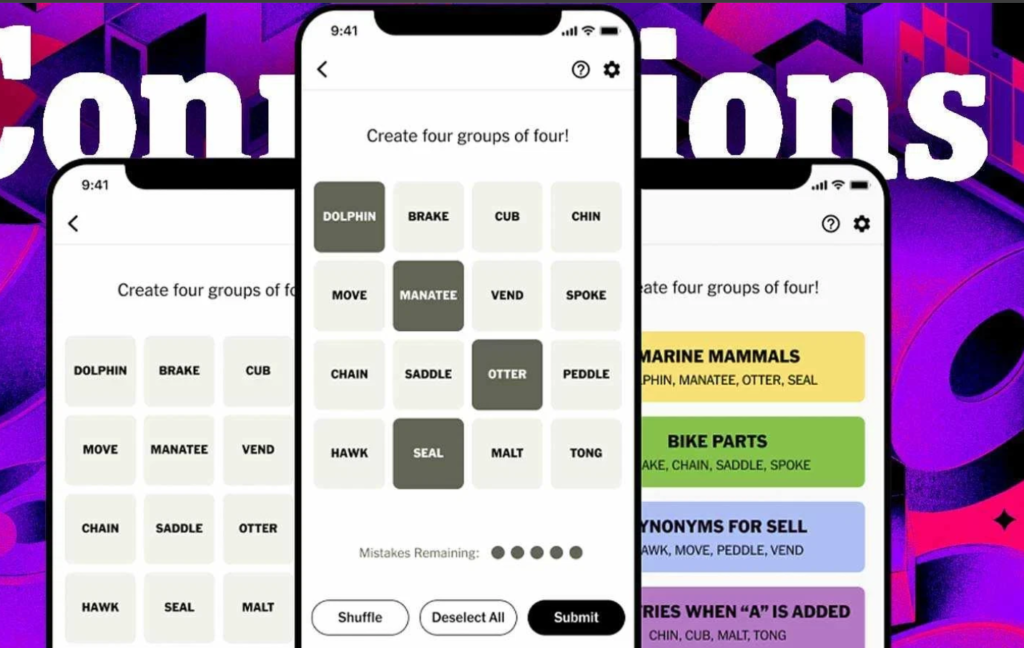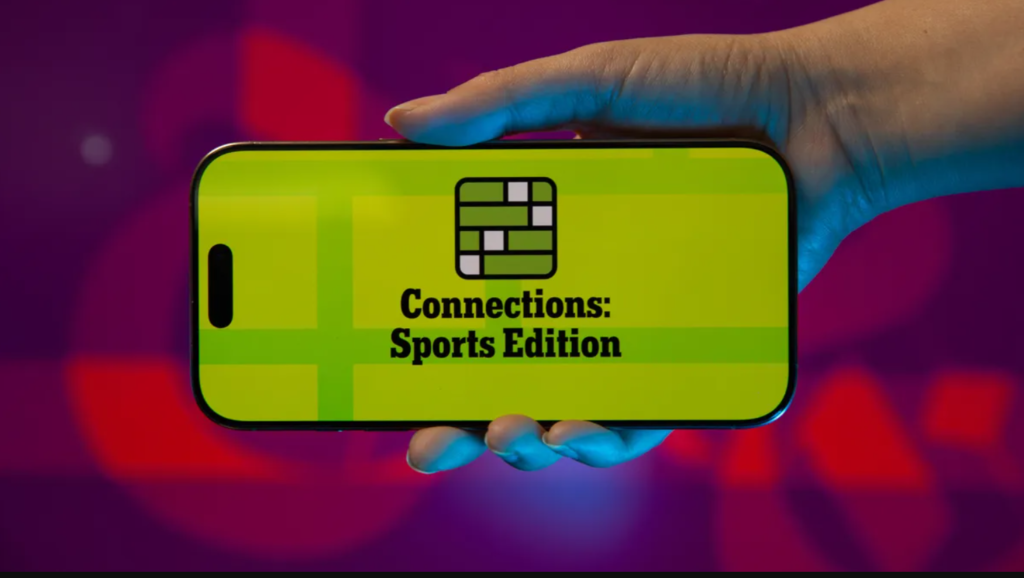Tech
Connections Hint: How to Improve Your Gameplay and Strategy
Published
8 months agoon
By
Bilal
If you’re a fan of word or puzzle games, you may already be familiar with Connections, a popular game that challenges players to find associations between words, phrases, or concepts. The game requires both critical thinking and creativity, making it a favorite for puzzle enthusiasts. However, as simple as the premise may seem, Connections can get tricky, especially as you advance to more difficult levels. This article is designed to give you some helpful connections hints that will improve your gameplay and strategy, helping you solve puzzles more efficiently and enjoy the game even more.
Whether you’re a beginner or a seasoned player, using effective strategies can make a significant difference in your success. With that in mind, let’s dive into some practical tips and hints that can help you make better connections in the game.
| Profile of Connections Game | Details |
|---|---|
| Game Name | Connections |
| Genre | Puzzle, Word Association |
| Primary Goal | Group related words or concepts |
| Platforms | Mobile, Web |
| Best For | Puzzle lovers, word enthusiasts |
| Levels | Increasing difficulty with progression |
| Skills Required | Critical thinking, pattern recognition |
| Ideal Strategy | Identifying themes, looking for patterns |
Understanding the Basics of Connections
Before diving into specific hints, it’s important to understand the basic mechanics of Connections. The game typically presents you with a list of words, and your objective is to group these words into categories based on some shared trait or association. Each word in a particular group has a “connection” with the others, such as similar meanings, references to a common theme, or shared characteristics.

For example, in a puzzle, you might see words like “red,” “blue,” “yellow,” and “green.” These words can be grouped together as “colors.” However, not every grouping is as straightforward, and as you advance, the categories and connections become increasingly complex. This is why having a strong strategy and approach to identifying connections is crucial for successful gameplay.
Connections Hint #1: Start with Obvious Groupings
One of the most effective ways to begin a Connections puzzle is to look for obvious groupings. These are words or terms that seem to share an immediate and apparent relationship. For example, if you see a set of animal names like “lion,” “tiger,” “bear,” and “elephant,” it’s safe to consider that these words might all belong in an “animals” group.
Starting with the obvious connections can help you clear out some words early, narrowing down the list and making it easier to find connections among the remaining terms. This approach helps to simplify the puzzle and gives you a strong foundation on which to build further connections.
Connections Hint #2: Look for Less Obvious Themes
Once you’ve grouped the obvious terms, move on to finding more subtle connections. For example, words might be linked by a common association that isn’t immediately clear. This could include references to pop culture, history, or shared features that are not as apparent. Let’s say you encounter words like “apple,” “pear,” “plum,” and “peach.” These words could belong to a “fruits” category, but in a more challenging puzzle, they might instead form a group of “trees that bear fruit.”

This step requires a bit of creative thinking and sometimes a knowledge of trivia, so don’t be afraid to think outside the box. Consider all possible ways the words might be related, even if they aren’t immediately obvious.
Connections Hint #3: Consider Synonyms and Word Associations
Many Connections puzzles involve grouping words based on synonyms or related words, rather than direct categories. For example, if you have words like “happy,” “joyful,” “gleeful,” and “elated,” they might all fall into a group related to emotions or positive feelings. These words are connected by their meanings rather than being part of a specific category.
By looking for synonyms or words with similar meanings, you can often find connections that might otherwise be overlooked. This approach can be particularly helpful in more challenging puzzles where direct categories are not as apparent.
Connections Hint #4: Use Process of Elimination
Process of elimination can be a powerful tool in Connections, especially when you’re dealing with tricky word lists. If you’ve grouped words that you’re confident belong together, remove them from your mental list (or cross them out if the game allows it). This way, you’re left with fewer options, which can make identifying the remaining connections easier.
For example, if you’ve successfully identified a group of “colors,” any remaining words are less likely to belong to that category. By eliminating options as you go, you can narrow down your choices and improve your chances of correctly grouping the remaining words.
Connections Hint #5: Pay Attention to Word Placement and Order
In some puzzles, the order of words or their arrangement might provide subtle clues. For instance, in themed puzzles, words that are closely related are sometimes placed near each other. If you notice a pattern in how words are grouped or if certain terms seem to be arranged in clusters, consider this as a possible hint.
However, don’t rely solely on word placement, as it isn’t always a surefire strategy. Think of it as an additional tool that might help you, especially in more advanced levels where every small detail counts.
Connections Hint #6: Think in Categories and Themes
A good strategy is to start thinking in terms of potential categories or themes as soon as you see the word list. Common categories include things like “sports,” “animals,” “emotions,” “foods,” and “colors.” But the themes can get more complex as the game progresses, including things like “items in a kitchen,” “types of trees,” or “characters from mythology.”
By familiarizing yourself with common categories and themes that are often used in word association games, you can approach each new puzzle with a mental checklist of possible groupings. This can speed up your process and help you make connections more intuitively.

Connections Hint #7: Recognize Patterns in Similar Games
If you enjoy Connections, there’s a good chance you’ve also played other word or puzzle games that use similar logic. Games like Wordscapes, Crossword Puzzles, and Scrabble all train your brain to recognize patterns and associations. Practice in these games can help you improve your Connections gameplay as well.
Look for connections similar to those you’ve seen in other word games. Often, the logic behind these games is based on common associations or language conventions, so practicing in one game can sharpen your skills in another.
Connections Hint #8: Take Breaks and Return with Fresh Eyes
One of the best ways to approach challenging puzzles is to take breaks and return to the game with fresh eyes. When you’ve been staring at the same list of words for a while, it can be easy to get stuck in a particular mindset. Stepping away for a few minutes allows your brain to reset, and you may notice connections that weren’t clear before.

Taking breaks is particularly useful when you’re working on a tough level and find yourself frustrated. Puzzle games are meant to be enjoyable, so giving yourself a break can also make the experience more enjoyable and reduce stress.
Advanced Strategies for Connections Masters
If you’re already comfortable with the basic and intermediate strategies, here are a few advanced techniques to push your Connections gameplay to the next level:
- Think Historically: Sometimes the connections are based on historical events or figures, requiring a bit of background knowledge. Terms like “Revolution,” “Declaration,” and “Constitution” might point towards a theme of “American History.”
- Consider Wordplay or Puns: Some puzzles use words with double meanings or puns to throw you off. For example, “bank” could relate to both financial institutions and riverbanks.
- Use External Knowledge: Occasionally, your general knowledge about pop culture, science, or literature can help. If you see terms like “Hobbit,” “Elf,” and “Dwarf,” they could be referring to characters in fantasy literature, such as Tolkien’s works.
These strategies require not only skill with language but also a broad base of knowledge, which can make Connections both challenging and rewarding.
Conclusion
Connections is more than just a word game; it’s a mental exercise that encourages creative thinking and tests your ability to spot patterns. By using these connections hints, you can improve your gameplay and tackle puzzles with greater confidence and efficiency. Remember, the joy of Connections comes from the satisfaction of identifying relationships between words, solving complex puzzles, and refining your logical thinking skills.
With practice, patience, and the right strategy, anyone can master Connections and enjoy the rewarding feeling of solving each level. So, whether you’re a beginner or a seasoned player, keep these hints in mind, and you’ll be well on your way to becoming a Connections pro.

Who Is Mason Reese? All About the American Former Child Actor’s

Who Is Lynn Hamilton? Celebrating the Life and Legacy of the American Actress

Who is Mickey Gooch Jr? The Dynamic Journey of a Film Producer and Actor

Who Is Pierre Bouvier? All About the Canadian Singer and Musician Behind Simple Plan

Who Is Pearl Minnie Anderson? Rising Star in Maya Rudolph’s Legacy

Who is Minnie Pearl? The American Comedian Who Brought Country Humor to the Spotlight

Who Is Kavan Smith? The Canadian Actor Known for His Versatile Roles

Who is Olivia Rose Cameron: The Creative Artist & Daughter of Kirk Cameron

Who Is Markella Kavenagh? All About the Australian Actress and Rising Star

Who is Tracey Hinds? Exploring the Life of Macy Gray’s Ex-Husband and Mortgage Broker

Who Is Dan Jeannotte? All About the Canadian Actor’s Career and Roles

Who Is Merri Kelly Hannity? All About Sean Hannity’s Daughter

Who Is Diana Espinoza Aguilar? The Story of Rafael Caro Quintero’s Wife

Who Is James Lesure? All About the American Film and Television Actor

Who is Eric Weinberger? A Visionary Television Producer Shaping Sports Media

Who is Charlee Fraser? The Rise of the Australian Model and Actress Making Global Waves

Who Is Toru Ohtani? All About Shohei Ohtani’s Father & Baseball Coach

Who Is Avantika Vandanapu? Rising American Actress & Singer

Who is Torrei Hart? The Multitalented Actress and Comedian Making Waves

Who Is Angellica Bell? All About the British Television Presenter

Who Is Mason Reese? All About the American Former Child Actor’s

Who Is Lynn Hamilton? Celebrating the Life and Legacy of the American Actress

Who is Mickey Gooch Jr? The Dynamic Journey of a Film Producer and Actor

Who Is Pierre Bouvier? All About the Canadian Singer and Musician Behind Simple Plan

Who Is Pearl Minnie Anderson? Rising Star in Maya Rudolph’s Legacy

Who is Minnie Pearl? The American Comedian Who Brought Country Humor to the Spotlight

Who Is Kavan Smith? The Canadian Actor Known for His Versatile Roles

Who is Olivia Rose Cameron: The Creative Artist & Daughter of Kirk Cameron

Who Is Markella Kavenagh? All About the Australian Actress and Rising Star

Who is Tracey Hinds? Exploring the Life of Macy Gray’s Ex-Husband and Mortgage Broker
Trending
-

 Celebrity12 months ago
Celebrity12 months agoNecati Arabacı: Net Worth, Biography, and More
-

 Celebrity1 year ago
Celebrity1 year agoDiscovering Lily Phillips: An Insight into Her Life and Career
-

 Celebrity11 months ago
Celebrity11 months agoEnrica Cenzatti: Life of Andrea Bocelli’s Ex-Wife
-

 Celebrity12 months ago
Celebrity12 months agoParker Schnabel’s Girlfriend: A Comprehensive Look at His Relationships Over the Years
